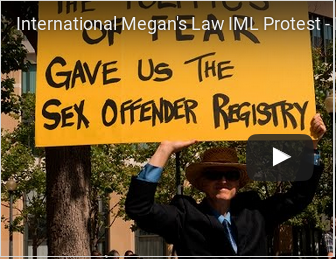Sexual violence is a serious social problem and policy-makers continue to wrestle with how to best address the public’s concerns about sex offenders. Recent initiatives have included social policies that are designed to prevent sexual abuse by restricting where convicted sex offenders can live. As these social policies become more popular, lawmakers and citizens should question whether such policies are evidence-based in their development and implementation, and whether such policies are cost-efficient and effective in reaching their stated goals.
Residence Restrictions
Many states have prohibited sex offenders from residing within close proximity to a school, park, day care center, school bus stop, or place where children congregate, with the most common restriction zone being 1,000 feet. In Spring 2005, after a series of child abductions and murders by convicted sex offenders, hundreds of jurisdictions across the U.S. began initiating housing restrictions with increasingly larger buffer zones, often 2,500 feet, or about one half mile. These laws have essentially banned sex offenders from living in some cities.
The constitutionality of residence restrictions was challenged in Iowa, and the state’s 2,000 foot restriction law was overturned in 2003. The Iowa Supreme court, however, later ruled that any infringement on sex offenders’ freedom of residency was superseded by the state’s compelling interest in protecting its citizens. The American Civil Liberties Union has asked the U.S. Supreme Court to rule on the issue. Housing restrictions have passed in most localities with little resistance. Child safety is rightly the primary concern when sex offender restrictions are imposed. It seems to makes sense that decreasing access to potential victims would be a feasible strategy for preventing sex crimes. There is no evidence, however, that such laws are effective in reducing recidivistic sexual violence. On the other hand, such laws aggravate the scarcity of housing options for sex offenders, forcing them out of metropolitan areas and farther away from the social support, employment opportunities, and social services that are known to aid offenders in successful community re-entry (Minnesota Department of Corrections, 2003). Sex offender residence restrictions Levenson, page 3 Are sex offender residence restrictions evidence-based?
Housing restrictions appear to be based largely on three myths that are repeatedly propagated by the media:
1) all sex offenders reoffend; 2) treatment does not work; and 3) the concept of “stranger danger.” Research does not support these myths, but there is research to suggest that such policies may ultimately be counterproductive.
All sex offenders reoffend. There is a common belief that the vast majority of sex offenders will repeat their crimes. In fact, several large studies by both the U.S. and Canadian governments have found that sex offense recidivism rates are much lower than commonly believed. The U.S. Department of Justice found that over a three year period after being released from prison, 5.3% of sex offenders were rearrested for a new sex crime (Bureau of Justice Statistics, 2003). Studies by Canadian researchers involving over 29,000 sex offenders from North America and Europe found a 14% recidivism rate among all sex offenders; child molesters were re-arrested at a slightly lower rate of about 13%, and rapists at a slightly higher rate of 19% (Hanson & Bussiere, 1998; Hanson & Morton-Bourgon, 2004). Despite the belief that sex offenders have the highest recidivism rates of all criminals, the Department of Justice found that sexual perpetrators were less likely to be rearrested for any new crime than were other types of offenders (Bureau of Justice Statistics, 2003). Official recidivism data always underestimate true reoffense rates, but it is clear that the majority of sexual offenders are unlikely to be rearrested for new sex crimes.
Treatment does not work. The myth that treatment can not be helpful to sex offenders is based largely on a highly publicized meta-analytic study that was unable to detect a treatment effect among outcome studies conducted in the 1970’s and 1980’s (Furby, Weinrott, & Blackshaw, 1989). Recent data have reported more promising results, suggesting that cognitive-behavioral treatment reduces sex offense recidivism by nearly 40% (Hanson, Gordon, Harris, Marques, Murphy, Quinsey, & Seto, 2002; Losel & Schmucker, 2005). Again, recidivism rates were lower than commonly believed; 17% for untreated offenders, and 10% for treated offenders (Hanson et al., 2002). Even in studies where significant overall treatment effects are not detected, researchers have found that sex offenders who Sex offender residence restrictions Levenson, page 4 successfully complete a treatment program reoffend less often than those who do not demonstrate that they “got it” (Marques, Miederanders, Day, Nelson, & van Ommeren, 2005).
Stranger danger. Sexual offender policies are also based on the myth of “stranger danger,” despite the fact that most sexual perpetrators are well known to their victims. The Department of Justice found that perpetrators reported that their victims were strangers in less than 30% of rapes and 15% of sexual assaults (Bureau of Justice Statistics, 1997). A study reviewing sex crimes as reported to police revealed that 93% of child sexual abuse victims knew their abuser; 34.2% were family members and 58.7% acquaintances (Bureau of Justice Statistics, 2000). Only seven percent of child victims reported that they were abused by strangers. About 40% of sexual assaults take place in the victim’s own home, and 20% take place in the home of a friend, neighbor or relative (Bureau of Justice Statistics, 1997).
Tragic cases of child abduction and sexually motivated murder receive extraordinary media attention, and the publicity of such events creates a sense of alarm and urgency among citizens. In reality, such cases are extremely rare; it is estimated that about 100 stranger abductions occur in the United States each year (National Center for Missing and Exploited Children, 2005). About .7% of all murders involve sexual assault, and in fact, the prevalence of sexual murders declined by about half between the late 1970’s and the mid 1990’s (Bureau of Justice Statistics, 1997). About 75% of sexual murder victims are adults (Bureau of Justice Statistics, 1997). In contract to sexual assault in general, the majority of sexually motivated murder victims were attacked by strangers or acquaintances.
Do residence restrictions work? Despite overwhelming public and political support, there is no evidence that proximity to schools increases recidivism, or, conversely, that housing restrictions reduce reoffending or increase community safety. Advocates of residence restrictions believe that such laws will diminish the likelihood that sex offenders will come in contact with children whom they might potentially victimize. In Colorado, however, it was found that molesters who reoffended while under supervision did not live closer than non-recidivists to schools or child care centers (Colorado Department of Public Safety, 2004). In Minnesota, sex offenders’ proximity to schools or parks did not increase the likelihood of reoffense (Minnesota Department of Corrections, 2003). Sex offender residence restrictions Levenson,
Continue readingSex Offender Residence Restrictions




